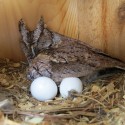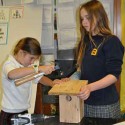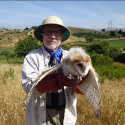 Photo ©
Keith Williams
Photo ©
Keith Williams

Owl About Birdhouses
Did you know that most owls do not build a nest or gather any nest-lining materials? (The notable exceptions are the Short-eared Owl and the Snowy Owl, which build ground nests.) Most North American owls depend upon a cavity in a dead tree or broken-off trunk if they are cavity-nesters, or they repurpose the old nests of other raptors if they are platform nesters. Sometimes, an old barn or duck blind will fill the need. Building a nest box or nest platform for your local owls is a fun fall project that will outlast any jack-o’-lantern. Right now, pairs are searching for suitable nest cavities in advance of the breeding season and calling to establish territories.
Eastern and Western screech-owls are commonly found in suburban neighborhoods with some tall trees, and in large cities with urban parks. Barred, Northern Saw-whet, and Boreal owls choose mature woodlands for their nesting sites, preferably near water. Barn Owls nest in open habitats, similar to bluebirds, and often choose agricultural areas. Great Horned and Great Gray owls will accept basket-style nesting platforms placed in the forest interior. Use our Right Bird, Right House tool to find out which owls nest in your region and habitat, plus tips for attracting them to your box or platform.
Shh—Day Sleepers!
Scientists still know very little about the breeding habits of owls, and their nocturnal ways make them difficult to study. You can help by installing a nest cam in your owl box and reporting your data to NestWatch. A nest cam helps you keep tabs on the owls without disturbing them during the day when they’re resting.

New Project on Youth Engagement
This month, NestWatch begins an exciting new project engaging youth in citizen science. With support from Smith-Lever Act funds, we’ll be working in two Upstate New York communities to build, install, and monitor nest boxes with youth and their parents.
These youth workshops will be used as a model to create a national curriculum on nest-box stewardship and citizen science. The curriculum, which we will be developing with help from our 4-H partners, will eventually be hosted online and available to any educator for free. Our goal is to introduce concepts of science and ecology focused on cavity-nesting birds to young people.

More California Nesting Data
Last month we told you about a massive data upload from the California Bluebird Recovery Program (CBRP), and mentioned that another 2,000+ nests were on the way. Well, they’ve arrived…2,129 nest records to be exact. These nest records come to us from Lee Pauser, an active member of the CBRP, and a volunteer for the Santa Clara Valley Audubon Society’s Cavity Nesters Recovery Program.
This recent addition to our bulk-imported data features 18 species and spans 14 years (that’s 6,796 fledglings!), resulting in very good coverage of the San Francisco Bay area. Lee also works with the Wildlife Center of Silicon Valley to retrieve injured or abandoned Barn Owl nestlings for rehabilitation, and eventual release. (Severe droughts in the area can lead to starvation and nest abandonment.)
If you or someone you know has old nest records that have not been permanently archived elsewhere, inquire about whether our Bulk Import Tool can work for you.